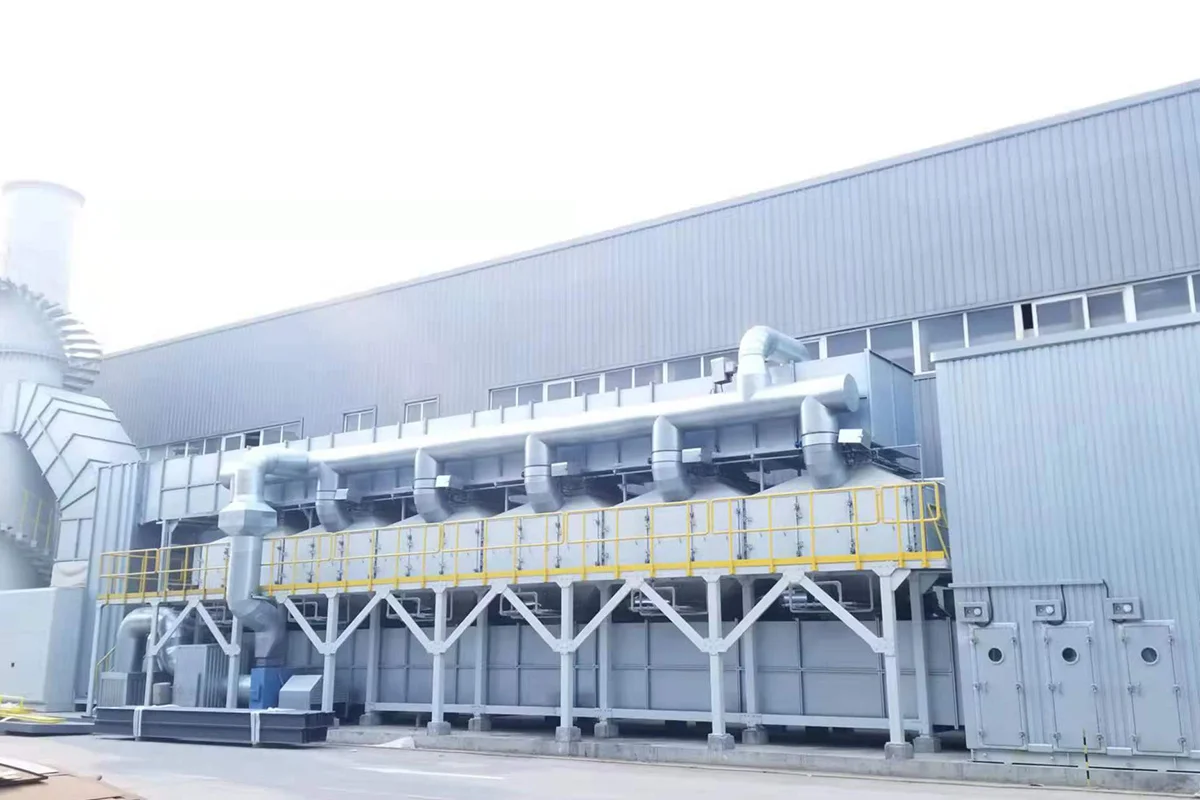
Clear records
history record

Products
Contact
VOC Exhaust Gas Treatment Equipment
VOC Exhaust Gas Treatment Equipment
I. Introduction
VOC (Volatile Organic Compound) exhaust gas treatment equipment is widely used in environmental protection due to its high treatment efficiency, energy-saving design, automated control, and modular structure. As technology advances, VOC treatment systems will evolve toward higher efficiency, intelligence, and sustainability, driven by innovations in energy-saving technology, smart integration, multifunctionality, eco-friendly materials, and regulatory policies.
II. Application Areas
1. Chemical Industry
Treats VOC emissions from production processes, including benzene, toluene, and xylene.
2. Oil Refining & Petrochemicals
Handles VOC emissions from refining, storage, and transportation, such as hydrocarbons and sulfur compounds.
3. Printing & Packaging
Removes organic solvent vapors like ethanol and ethyl acetate from printing and coating processes.
4. Coating & Spray Painting
Processes VOCs from automotive, furniture, and electronics painting, including benzene derivatives and ketones.
5. Pharmaceutical Industry
Treats organic emissions from drug synthesis and extraction, such as chloroform and acetone.
6. Electronics Manufacturing
Handles VOCs from semiconductor and PCB production, including cleaning and etching processes.
7. Food & Beverage Industry
Processes organic waste gases from fermentation and cooking, such as ethanol and acetic acid.
8. Furniture Manufacturing
Removes formaldehyde and benzene derivatives from wood processing and painting.
9. Rubber & Plastics Industry
Treats VOC emissions from rubber and plastic production, such as styrene and vinyl chloride.
10. Waste Management & Sewage Treatment
Handles VOCs from landfills, incineration, and wastewater treatment, including hydrogen sulfide and ammonia.
11. Automotive Repair & Maintenance
Treats VOCs from spray painting and baking processes.
12. Laboratories & Research Institutions
Processes solvent vapors and organic exhaust from experiments.
III. Technical Overview
1. Basic Principles
VOC-laden exhaust gas is collected and pretreated (e.g., dust removal, dehumidification) before entering the purification system. Inside the system, the gas interacts with adsorbents, catalysts, or high-temperature environments, converting VOCs into harmless substances before releasing purified air into the atmosphere.
2. Core Process Flow
Exhaust Gas Collection
Captures VOC emissions at the source using extraction hoods, pipelines, and ducts, directing them to the treatment unit.
Pre-Treatment
Filtration: Removes particulates to prevent clogging.
Cooling/Heating: Adjusts gas temperature to optimize treatment efficiency.
Adsorption
Uses activated carbon or zeolite to adsorb VOCs, suitable for low-concentration exhaust gas.
Concentration
Adsorption-desorption cycles concentrate VOCs into high concentrations for easier processing.
Oxidation & Decomposition
Thermal Oxidation (RTO): Burns VOCs at high temperatures, converting them to CO? and H?O.
Catalytic Oxidation (RCO): Uses catalysts to lower oxidation temperature, reducing energy consumption.
Biological Oxidation: Uses microorganisms to break down VOCs, ideal for low-concentration exhaust.
Absorption
Liquid scrubbers (e.g., water or chemical solutions) absorb water-soluble VOCs.
Condensation
Lowers temperature to convert VOCs into liquid form, suitable for high-concentration exhaust.
Secondary Treatment
Residual VOCs and byproducts are further treated to eliminate odors and meet emission standards.
Exhaust Gas Release
Treated air is tested and discharged through chimneys in compliance with environmental regulations.
Monitoring & Control System
Real-time monitoring of gas concentration and temperature ensures stable operation and compliance.
IV. Technical Advantages
1. High Processing Efficiency
VOC removal rates exceed 95% in modern systems like RTO and RCO.
Versatile applications for various VOC types and concentrations.
2. Energy-Saving & Eco-Friendly
Heat Recovery: RTO and RCO systems recycle heat, reducing energy consumption.
Low Secondary Pollution: Generates minimal byproducts, meeting strict environmental regulations.
3. Intelligent Automation
Smart Monitoring: PLC and DCS systems enable automated operation and remote monitoring.
Stable & Reliable: Automated control reduces manual intervention, ensuring long-term operation.
4. Modular Design
Flexible Configurations: Systems can be scaled based on processing needs.
Easy Maintenance: Modular components simplify maintenance and part replacement.
V. Development Trends
1. High-Efficiency & Energy-Saving Technologies
New Catalysts: Developing more efficient, durable catalysts to improve VOC breakdown while reducing energy use.
Optimized Energy Recovery: Further improving heat recovery efficiency in RTO/RCO systems.
2. Smart & Digitalized Systems
IoT Integration: Enables real-time monitoring and remote diagnostics for predictive maintenance.
Big Data Analytics: Uses data-driven optimization to enhance efficiency and operational stability.
3. Multifunctional & Integrated Solutions
Hybrid Technologies: Combining adsorption + catalytic oxidation for enhanced VOC removal.
Multi-Pollutant Treatment: Developing systems that handle VOCs alongside other pollutants.
4. Green & Sustainable Materials
Eco-Friendly Equipment Materials: Using environmentally sustainable materials for VOC processing units.
Recyclable System Design: Enhancing equipment recyclability and resource efficiency.
5. Stricter Regulations & Policy Support
Government Incentives: Stricter environmental policies drive technological advancements.
Global Compliance: VOC treatment equipment aligns with international emission standards, improving global market competitiveness.










